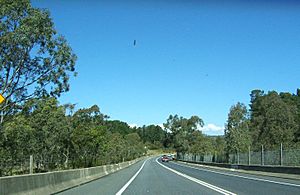Happy Valley, South Australia facts for kids
Quick facts for kids Happy ValleyAdelaide, South Australia |
|||||||||||||||
|---|---|---|---|---|---|---|---|---|---|---|---|---|---|---|---|

Western end of Windebanks Drive
|
|||||||||||||||
| Postcode(s) | 5159 | ||||||||||||||
| Location | 20 km (12 mi) from Adelaide | ||||||||||||||
| LGA(s) | City of Onkaparinga | ||||||||||||||
| Region | Southern Adelaide | ||||||||||||||
| County | Adelaide | ||||||||||||||
| State electorate(s) |
|
||||||||||||||
| Federal Division(s) | Kingston | ||||||||||||||
|
|||||||||||||||
Happy Valley is a suburb in Adelaide, South Australia. It's about 20 kilometers south of Adelaide's city center. This area is home to the Happy Valley Reservoir. It also has South Australia's largest water treatment plant. This plant helps supply water to much of the Adelaide area. Even though it's surrounded by other suburbs, Happy Valley still feels a bit like the countryside. This is because of the native plants and trees around the reservoir. There are also parklands and golf courses nearby.
Contents
History of Happy Valley
The Kaurna people originally called this area "Warekila." This name means 'place of changing winds.' Later, a settler named Edward Burgess is thought to have given it the name "Happy Valley." He arrived in South Australia in 1837 and started farming here. The South Australian Company also bought land in the area. They offered it to other settlers.
By 1866, Happy Valley was a farming settlement. It was known for growing wheat. It also had a good road connecting it to Dashwood's Gully. The area was close to the postal village of O’Halloran Hill. There was even a public pound and a Forester's court.
Farming and Wineries
Over the next twenty years, more land was used for growing grapes. This led to a big increase in wine production. Families like the Douglases were important grape growers. Large wineries, such as Horndale and Mount Hurtle, were built. Rich investors helped fund these wineries.
Building the Happy Valley Reservoir
Between 1892 and 1896, the Happy Valley Reservoir was built. This project created many jobs for local people. However, it also flooded many farms in the area. Many farming families had to move to other nearby lands. They continued their work there.
After the reservoir was built, the original Happy Valley town was flooded. This included the school and the cemetery. The town was moved about 4 kilometers to the east. The cemetery was moved to the west. It is now next to the dam wall in O'Halloran Hill. The school also moved to a new site.
There's a myth that the old church steeple can be seen when the reservoir water is low. Some people think the whole town is still underwater. But this is not true. All buildings were taken down before the area was flooded. Any useful materials, like fruit trees, were sold. What people saw at low water was actually a pump frame. Maps show the original church was under the dam wall.
From 2002 to 2004, the reservoir was drained for repairs. This was a big project to improve the dam. When the water level was low, archaeologists explored the old town site. They found very little, mostly scattered bricks. They could only identify the foundations of the old Post Office.
In 1983, the local council changed its name. It became the City of Happy Valley. This was because of the growing population in Happy Valley.
Railway History
Happy Valley used to have a train station. It was on the Hallett Cove-Willunga railway line. The station operated from 1915 until 1969. Today, the station is gone. The site is now part of the Southern Expressway.
Country Fire Service (CFS)
The Happy Valley CFS started in 1939. It is located on Glory Court in Happy Valley. This fire brigade is made up entirely of volunteers. They have active firefighters, cadets, and auxiliary members.
The Happy Valley CFS responds to over 250 calls each year. These calls can be for many things. They include fixed alarms, building fires, and large bushfires. They also help other areas when needed. The brigade mainly covers Happy Valley, Woodcroft, Onkaparinga Hills, Aberfoyle Park, and Flagstaff Hill. They also train with the Metropolitan Fire Service (MFS). This helps them assist with emergencies at the Flinders Medical Centre.
The brigade has three fire trucks:
- A 2000-liter urban pumping truck for city emergencies.
- A 3000-liter rural truck for bushfires and large fires.
- A smaller 280-liter quick response vehicle.



